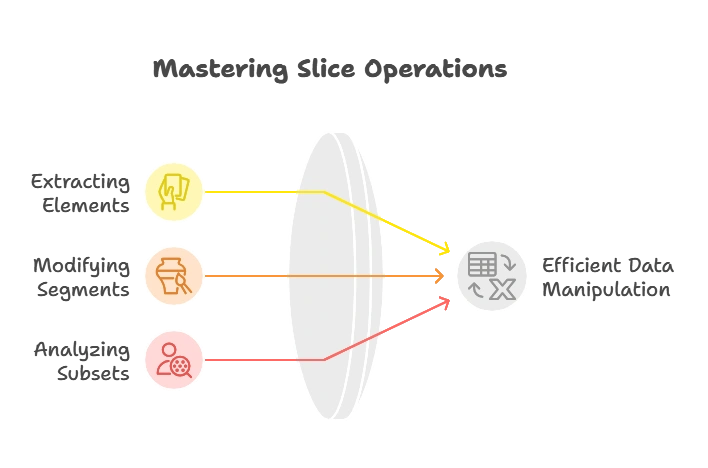Slice in Go
Welcome to the comprehensive guide to slices in Go! In this chapter, we'll explore everything about slices, from the basics to advanced techniques. By the end of this chapter, you'll have a thorough understanding of how to use slices effectively in your Go programs.
Understanding Slices
What are Slices?
Slices in Go are a powerful abstraction built on top of arrays. They provide a more flexible and convenient way to work with collections of elements compared to arrays. Slices are dynamic, allowing you to change their length during runtime.
Declaring Slices
In Go, you declare a slice using the following syntax:
var sliceName []dataType
Here, sliceName is the name of the slice, and dataType is the type of elements the slice can store. Unlike arrays, slices don’t have a fixed size specified during declaration.
Creating Slices
Slices can be created using the make() function or by slicing an existing array or another slice. Here are some examples:
slice1 := make([]int, 3) // Creating a slice of length 3
slice2 := []int{1, 2, 3} // Creating a slice with initial values
array := [5]int{1, 2, 3, 4, 5}
slice3 := array[1:4] // Creating a slice from an array
Basic Slice Operations

Accessing Slice Elements
You can access individual elements of a slice using the index, similar to arrays. In Go, slice indices start from 0. For example:
fmt.Println(slice2[0]) // Output: 1
fmt.Println(slice3[2]) // Output: 4
Modifying Slice Elements
You can modify slice elements by assigning new values to them:
slice2[1] = 10
fmt.Println(slice2) // Output: [1 10 3]
Slicing Slices
You can create new slices from existing slices by specifying a range of indices. This is called slicing. For example:
slice4 := slice2[1:2] // Creating a slice from index 1 to index 2 (exclusive)
fmt.Println(slice4) // Output: [10]
Accessing Slice Elements
You can access individual elements of a slice using the index, similar to arrays. In Go, slice indices start from 0. For example:
fmt.Println(slice2[0]) // Output: 1
fmt.Println(slice3[2]) // Output: 4
Appending to Slices
One of the most powerful features of slices is the ability to dynamically resize them by appending elements. For example:
slice2 = append(slice2, 4) // Appending an element to the slice
fmt.Println(slice2) // Output: [1 10 3 4]
Advanced Slice Concepts
Copying Slices
Go provides a built-in copy() function to copy elements from one slice to another. This allows you to create independent copies of slices. For example:
slice5 := make([]int, len(slice2))
copy(slice5, slice2)
fmt.Println(slice5) // Output: [1 10 3 4]
Resizing Slices
You can resize slices by re-slicing them with different lengths. This allows you to remove elements from the end of a slice or increase its length. For example:
slice2 = slice2[:3] // Resizing the slice to length 3
fmt.Println(slice2) // Output: [1 10 3]
Using Slices of Slices
Slices can contain other slices, creating a multi-dimensional data structure. This is useful for representing matrices, tables, or other complex data. For example:
matrix := [][]int{{1, 2}, {3, 4}}
fmt.Println(matrix[1][0]) // Output: 3
Reslicing Slices
Reslicing allows you to create a new slice from an existing slice, specifying a new range of indices. This is useful for extracting subsets of a slice or modifying existing slices without altering the original data. For example
slice := []int{1, 2, 3, 4, 5}
subSlice := slice[1:4] // Extracting a subset from index 1 to index 4 (exclusive)
fmt.Println(subSlice) // Output: [2 3 4]
// Modifying the original slice
slice[2] = 10
fmt.Println(subSlice) // Output: [2 10 4]
Deleting Elements from Slices
Although Go doesn’t provide a built-in function to delete elements from slices directly, you can achieve this by using append and reslicing. Here’s an example of deleting an element at a specific index:
slice := []int{1, 2, 3, 4, 5}
index := 2
slice = append(slice[:index], slice[index+1:]...)
fmt.Println(slice) // Output: [1 2 4 5]
Iterating Over Slices
You can iterate over slices using loops, similar to arrays. The range keyword is often used for this purpose, providing both the index and value of each element. For example:
slice := []int{1, 2, 3}
for index, value := range slice {
fmt.Printf("Index: %d, Value: %d\n", index, value)
}
Using Slices with Maps
Slices can be used as values in maps, allowing you to create more complex data structures. This is useful for scenarios where you need to associate multiple values with a single key. For example:
m := make(map[string][]int)
m["key1"] = []int{1, 2, 3}
m["key2"] = []int{4, 5, 6}
fmt.Println(m["key1"]) // Output: [1 2 3]
Working with Pointers and Slices
Slices are reference types in Go, meaning they are essentially pointers to underlying array data. This allows for efficient memory usage and enables slices to share the same underlying array. However, you need to be careful when working with pointers and slices to avoid unintended side effects. For example:
slice1 := []int{1, 2, 3}
slice2 := slice1 // Both slice1 and slice2 point to the same underlying array
slice2[0] = 100
fmt.Println(slice1) // Output: [100 2 3]
Slices are a powerful feature of Go, providing dynamic, flexible, and efficient ways to work with collections of elements. By understanding the basics and advanced concepts of slices, you'll be well-equipped to handle a wide range of programming tasks effectively in Go. Happy coding !❤️
